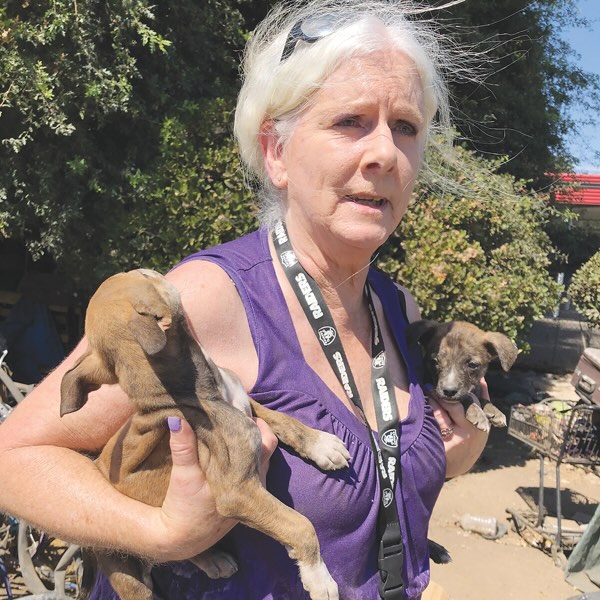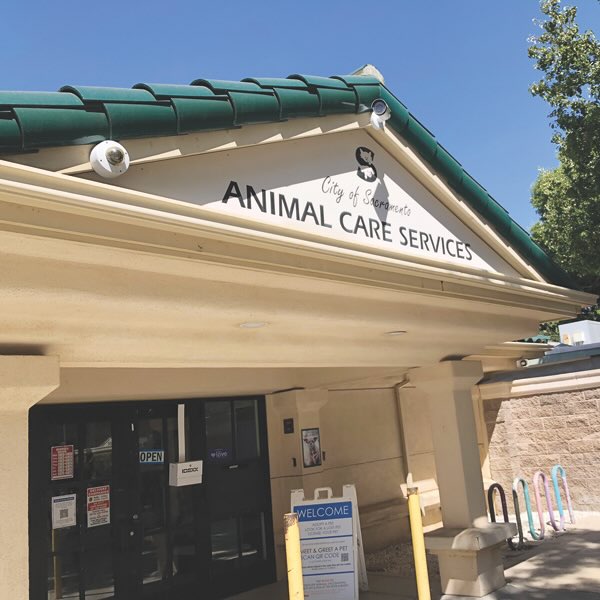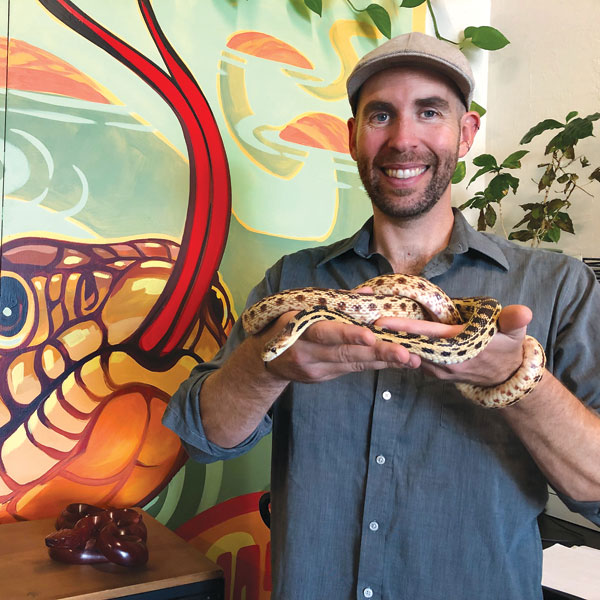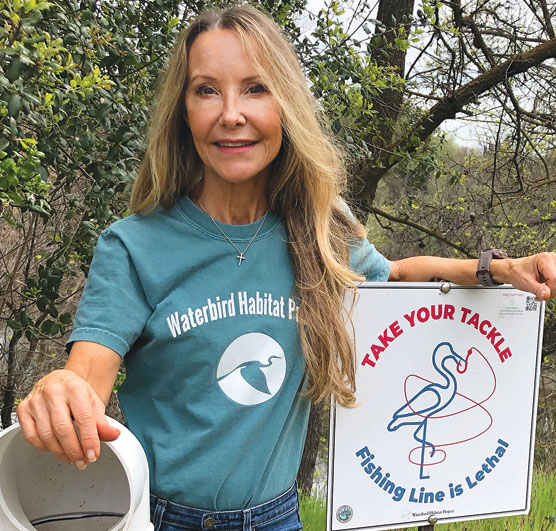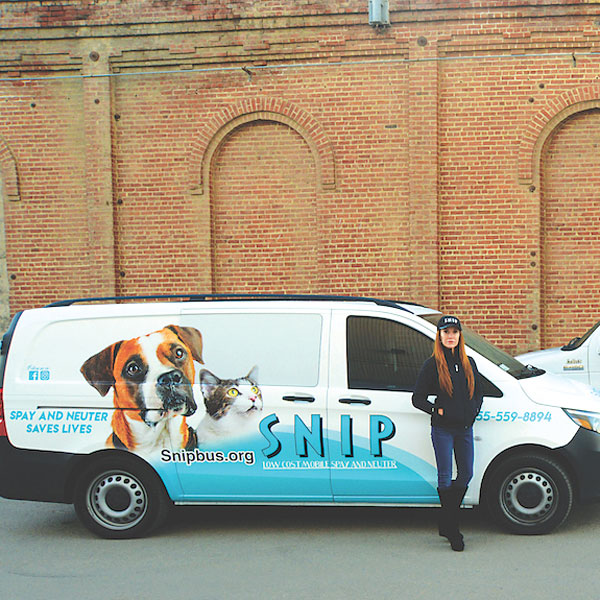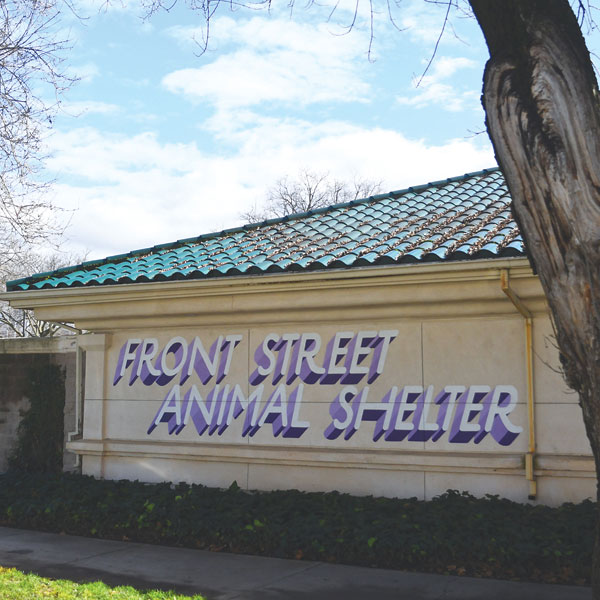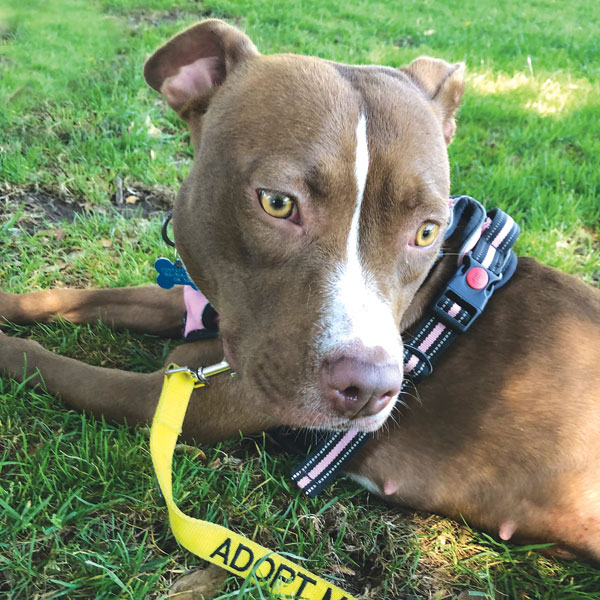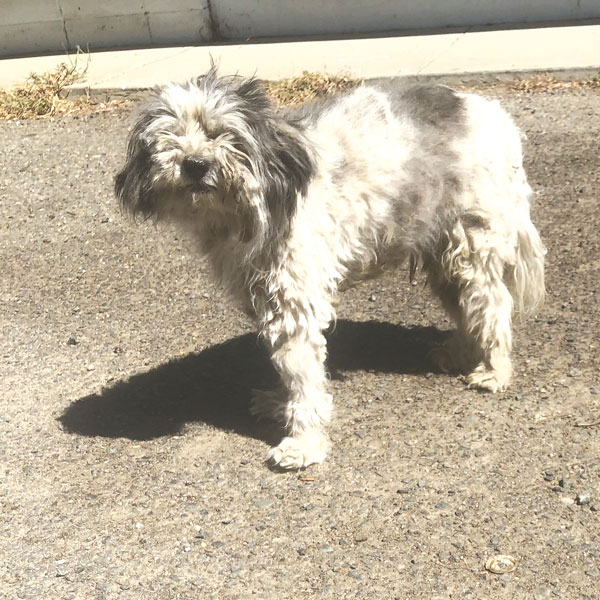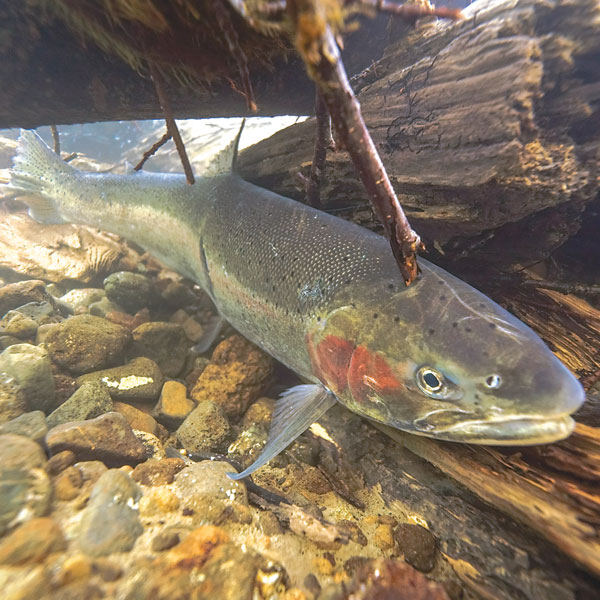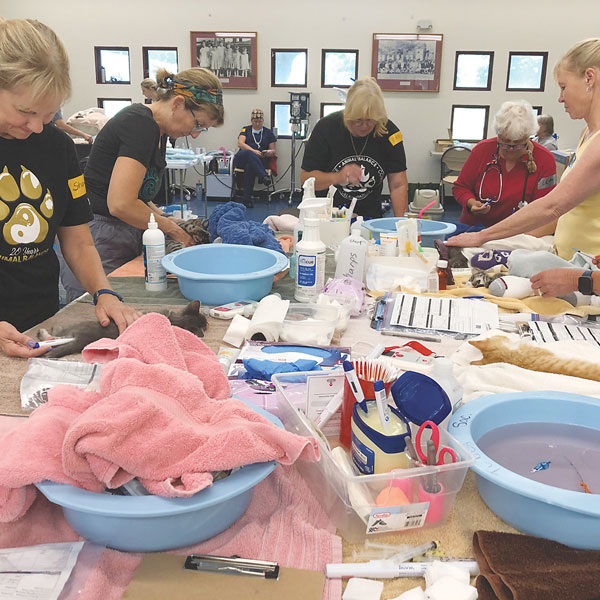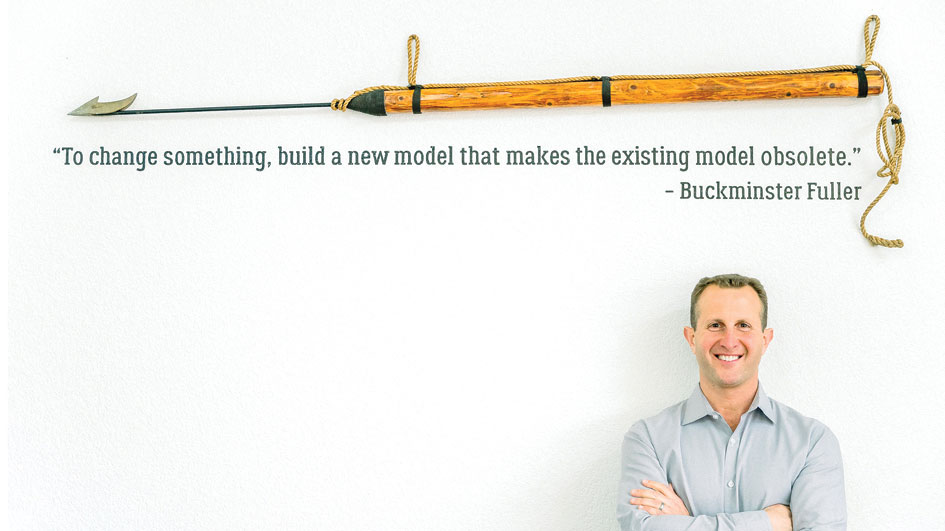Animals & Their Allies
What’s It Going To Take
Buttercup lives on a 3-foot tether in a homeless camp near Downtown. The tan, mixed-breed dog is 3 years old. She’s had three litters—24 puppies.
Buttercup is one of three dozen dogs who have lived and died in a lineup of tattered tents off Highway 160 over the last three years.
In that time, 155 puppies were born. Forty-nine died, 65 were sold or traded, 25 are gone.
“Gone means the puppies just disappeared,” Debbie Tillotson says.
Under Her Watch
Kennel floors covered in excrement. Beds and blankets crusted with diarrhea and vomit. Water bowls lined with green slime.
Animals languished in squalid and inhumane conditions without relief under the leadership of Staycee Dains, then-general manager of Los Angeles Animal Services, according to reports from a national animal welfare organization.
Now Dains is shelter operations manager at Sacramento city’s Front Street Animal Shelter.
Dains held leadership positions at animal shelters in Pasadena, Santa Cruz, San Jose, Long Beach and Ohio. In 2023, she was named general manager of Los Angeles Animal Services, overseeing six LA city shelters.
Disturbing Allegations
Under Philip Zimmerman’s leadership over the last five years, the city’s Front Street Animal Shelter has ignored spay/neuter laws, increased euthanasia, turned away unaltered stray animals and let hundreds of animal control service calls go unanswered.
A recent city audit also cites a lack of a community spay/neuter program, overcrowded kennels, unfinalized policies, uncollected fees and low employee morale.
Now, Zimmerman has hired Staycee Dains to run Front Street’s shelter operations.
Dains, previously with Long Beach and San Jose animal shelters, was named general manager of Los Angeles Animal Services in 2023, overseeing six LA city shelters.
Too Little, Too Late
It’s not complicated. High-volume spay/neuter is the most effective way to stop the influx of unwanted dogs and cats.
Lacking such a program, Front Street Animal Shelter has big problems.
In the five years since Phillip Zimmerman took over as Front Street manager, the city’s homeless animal population has exploded. Stray dogs and cats entering Front Street grew from 6,309 in 2022 to 8,457 in 2024.
Saving Snakes
California has a state bird, bat, amphibian, reptile, crustacean, flower, grass, mushroom, tree, insect, slug, seashell, rock—but no snake.
Michael Starkey wants to change that with the giant garter snake.
Reaching 64 inches long, the giant garter snake is a threatened species found only in the Central Valley. He lives in freshwater marshes, such as Yolo County’s flooded rice fields. He eats fish and amphibians, including the invasive American bullfrog.
Take Your Tackle
A great blue heron flew over Dr. Andrea Willey’s kayak on the lower American River. Something dangled from the waterbird’s beak.
The heron crossed the river and landed on an island. “I saw the top of a single tree shake violently. That’s when I realized something was wrong,” Willey says.
Willey paddled to land, climbed the riverbank and crossed felled trees until she found the bird. “He had swallowed a fishing hook and hung himself in the tree. He was spinning and flailing.”
Willey cut the heron loose with her bike lock key. Unable to restrain him, the bird flew off.
“I searched and searched. I had to locate him,” Willey says. So she assembled a group of volunteers. “We rescued the bird three days later. Unfortunately, he died the next day.”
That was August 2023. The Waterbird Habitat Project was born.
No Excuse
The city’s Front Street Animal Shelter has a problem. Unwanted pets keep coming.
In three years, stray dogs and cats entering Front Street increased by 2,148—from 6,309 in 2022 to 8,457 in 2024.
More animals mean more killing. In 2022, Front Street euthanized 747. In 2024, the shelter killed 1,462—nearly double.
To address the statewide animal overpopulation crisis, Gov. Gavin Newsom included $50 million in the 2020-21 state budget to help California animal shelters stop killing adoptable dogs and cats.
Four years later the killing continues.
It’s The Law
There are many ways to work around the law. Let’s start with the nearly 600 dogs and cats in “foster to adopt” at the city’s Front Street Animal Shelter, headed by Manager Phillip Zimmerman.
The concept is simple. California law requires shelters to spay or neuter animals prior to adoption. Under “foster to adopt,” animals are released to “adopters” as “foster pets.”
As foster pets, they don’t need to be altered before leaving the shelter.
Next Level
Without hesitation, Jennifer Brent says spay and neuter is the most important service the Sacramento SPCA offers the community.
“I think it’s the most powerful tool we have to limit pet overpopulation,” says Brent, who was recruited last year to head the SSPCA after CEO Kenn Altine retired.
Brent says the SSPCA is a national leader in spay/neuter, calling its 10,000-square-foot Zoe K. McCrea Animal Health Center “phenomenal.” The center performed more than 18,000 low- and no-cost spay/neuter surgeries in 2024.
Day Tripping
Cinnabon is a cinnamon-colored pit bull, all muscle with a tongue that dangles from a smile stretching the limits of her wide jawbones.
Okapi, a solid black German shepherd, has gigantic puppy paws that, at 4 years old, she has yet to grow into.
Tom is a senior—an 8-year-old mix of rottweiler, shepherd, perhaps a little pit bull.
All three dogs are gentle, calm and curious. They are ideal candidates to get out of the county animal shelter and walk a park trail, lounge on shaded grass, sneak favors on a restaurant patio—even for just one day.
Left Behind
The dog stood in front of a used tire shop in an industrial section of town. His gait was slow and weary over dirt and gravel. A cardboard box on a cement pad by the front door was his makeshift doghouse.
Filth gripped his ratty black and white fur. Twisted mats hung from his torso.
A passerby called 311 to report a loose dog in poor condition. A city animal control officer went out. He spoke to the dog’s owner and left—without the dog.
“We did go out and while it’s not the best setup for him, he does have access to the back area of the shop,” says Phillip Zimmerman, manager at the city’s Front Street Animal Shelter.
Fish Fight
The green sturgeon is an ancient creature. This “river dinosaur” dates back 220 million years. Today he thrives in local waterways.
The southern green sturgeon spawns in a small segment of the Sacramento River and uses the lower American River for juvenile rearing.
Despite the green sturgeon’s resiliency, the species is listed as threatened under the federal Endangered Species Act.
MASH Up
It started in the Galapagos 20 years ago. The first spay/neuter clinic was on Isabela Island. The first patient was a dog named Luna.
Today, Animal Balance deploys high-volume temporary MASH clinics (Mobile Animal Sterilization Hospitals) in 10 countries, including the United States.
In March, Sacramento hosted its first three-day MASH in partnership with Sacramento County’s Bradshaw Animal Shelter, converting a county-owned building at McClellan Park into a spay/neuter hospital.
Ferment To Fork
A whale harpoon hangs on the reception area wall. A relic to prove a point: To change something bad, create something better.
“For thousands of years we harpooned whales to light our homes,” says Paul Shapiro, CEO of The Better Meat Co. “We didn’t stop because we care about whales. We stopped because kerosene was a cheaper way to light our house.”
Humans whipped horses to get from one place to another. That ended when cars were invented. Feathers were plucked from live geese for writing, until the metal fountain pen came along.
Path Of Destruction
The slightest noise—heavy footstep, rustling branch, loud whisper—will send the northwestern pond turtle off a sunlit log and into his safe place, the cool waters of the American River.
He’s a shy creature. The booming sounds of heavy machinery tearing up his riparian habitat will not bode well for him.
Next summer, the U.S. Army Corps of Engineers will begin another phase of its erosion-control project along the lower American River from the Howe Avenue bridge to east of Watt Avenue.
Trucks, tractors and excavators will bulldoze through the wild and scenic parkway landscape.
Just in time for northwestern pond turtle nesting season.

